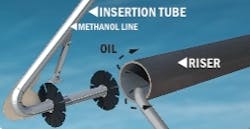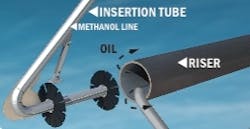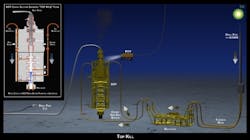BP oil spill: Siphon now working, collecting 'some' oil; Concerns turn toward 'loop current'
May 17, 2010 -- BP engineers spent much of the past weekend tweaking their attempt to siphon oil out of the broken riser pipe in the waters of the Gulf of Mexico 5,000 feet below the surface.
The first attempt was thwarted when equipment shifted during deployment. The unit had to be hoisted back up to the surface on Saturday morning for adjustment.
This amount has been hotly debated since raw video of the ruptured pipe was released last week. Experts who have examined the footage say the flow could be many times that -- perhaps as much as 70,000 barrels per day according to an NPR report released last week.
In order to minimize the possibility of ice crystals forming in the tube, BP crews plan to slowly increase the amount of oil being collected by the siphon over the next few days.
Secretary of Homeland Security Janet Napolitano and Secretary of the Interior Ken Salazar said in a joint statement, "This technique is not a solution to the problem, and it is not yet clear how successful it may be. We are closely monitoring BP’s test with the hope that it will contain some of the oil, but at the same time, federal scientists are continuing to provide oversight and expertise to BP as they move forward with other strategies to contain the spill and stop the flow of oil."
"We will not rest until BP permanently seals the wellhead, the spill is cleaned up, and the communities and natural resources of the Gulf Coast are restored and made whole,” they said.
BP is also preparing for a 'top kill' of the well, meaning that they intend to inject mud and cement into the blowout preventer (BOP) in an attempt to seal it up (see figure below). If that doesn't work, they will try a 'junk shot,' which is shooting debris such as golf balls and tire remnants into the opening to plug it up.
Preparations for a relief well are still ongoing. The Minerals Management Service has reported that the blowout preventer (BOP) stack and riser are constructed and the BOP is being attached to the wellhead. However, it could still be several months before the relief well is operational.
Application of subsea and surface dispersants continues. Over 600,000 gallons of the chemical have been deployed to date.
With the latest containment efforts underway, attention seems to have turned to the enormous plume of oil floating 2,000 to 3,000 feet below the surface. The Associated Press is reporting that computer models indicate some of the oil may have entered the 'loop current,' a powerful stream that could push the oil around the Florida Keys and possibly up the East Coast. Yet another computer model, however, shows the oil is still several miles away from the current.
Estimates as to the size of the plum are varied. One University of Southern Mississippi professor, Vernon Asper, told NPR that it could be 15 for 20 miles long and possibly 4 or 5 miles wide.
It's been difficult for researchers to say exactly how big the plume is because the oil content is still being analyzed and some types of compounds can confuse the sensors and make readings unreliable.
In any case, environmentalists and researchers are concerned that because the oil depletes oxygen levels around it, marine life will be adversely affected.
Related Articles
BP oil spill: Setback in attempt to siphon oil from gulf waters, engineers will try again >
BP oil spill: Cleanup battle rages on in waters of Gulf of Mexico >
BP oil spill: Update on cleanup of gulf waters, underwater video released>
BP oil spill: Clean up of gulf waters continues >
BP oil spill: Measures to mitigate wetland damage, stem flow ...>
BP oil spill: Clean-up attempt fails, wetlands under grave threat >
###


